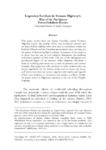Mostrar o rexistro simple do ítem
Legendary Survivors in Tomson Highway’s Kiss of the Fur Queen
| dc.contributor.author | Collellmir Morales, Dolors | |
| dc.date.accessioned | 2016-07-15T08:35:31Z | |
| dc.date.available | 2016-07-15T08:35:31Z | |
| dc.date.issued | 2008 | |
| dc.identifier.citation | AEDEAN 2008, 31: 599-607 ISBN-978-84-9749-278-2 | |
| dc.identifier.isbn | 978-84-9749-278-2 | |
| dc.identifier.uri | http://hdl.handle.net/2183/17072 | |
| dc.description.abstract | [Abstract] This paper studies how the Native Canadian author Tomson Highway depicts the terrible effects that residential schools had on many Indian children who were sent to institutions where the Catholic Church and the Canadian government were carrying out the policy of destroying Native culture. A purpose of this paper is to show how the use of oral tradition determines the aesthetic and ethical qualities of this novel. The use of the ambiguous and paradoxical figure of the trickster helps Highway transform a story of suffering and abuse into a story of personal and cultural triumph. This paper also calls attention to other elements that are deeply significant for the Indian mind, such as music and dance and shows how they are woven together with myths and legends of the Cree tradition to illuminate and resolve conflicts. Finally, the paper refers to Highway’s mastery in his use of the English language. | |
| dc.language.iso | eng | |
| dc.publisher | Universidade da Coruña | |
| dc.title | Legendary Survivors in Tomson Highway’s Kiss of the Fur Queen | |
| dc.type | info:eu-repo/semantics/conferenceObject | |
| dc.rights.access | info:eu-repo/semantics/openAccess |






